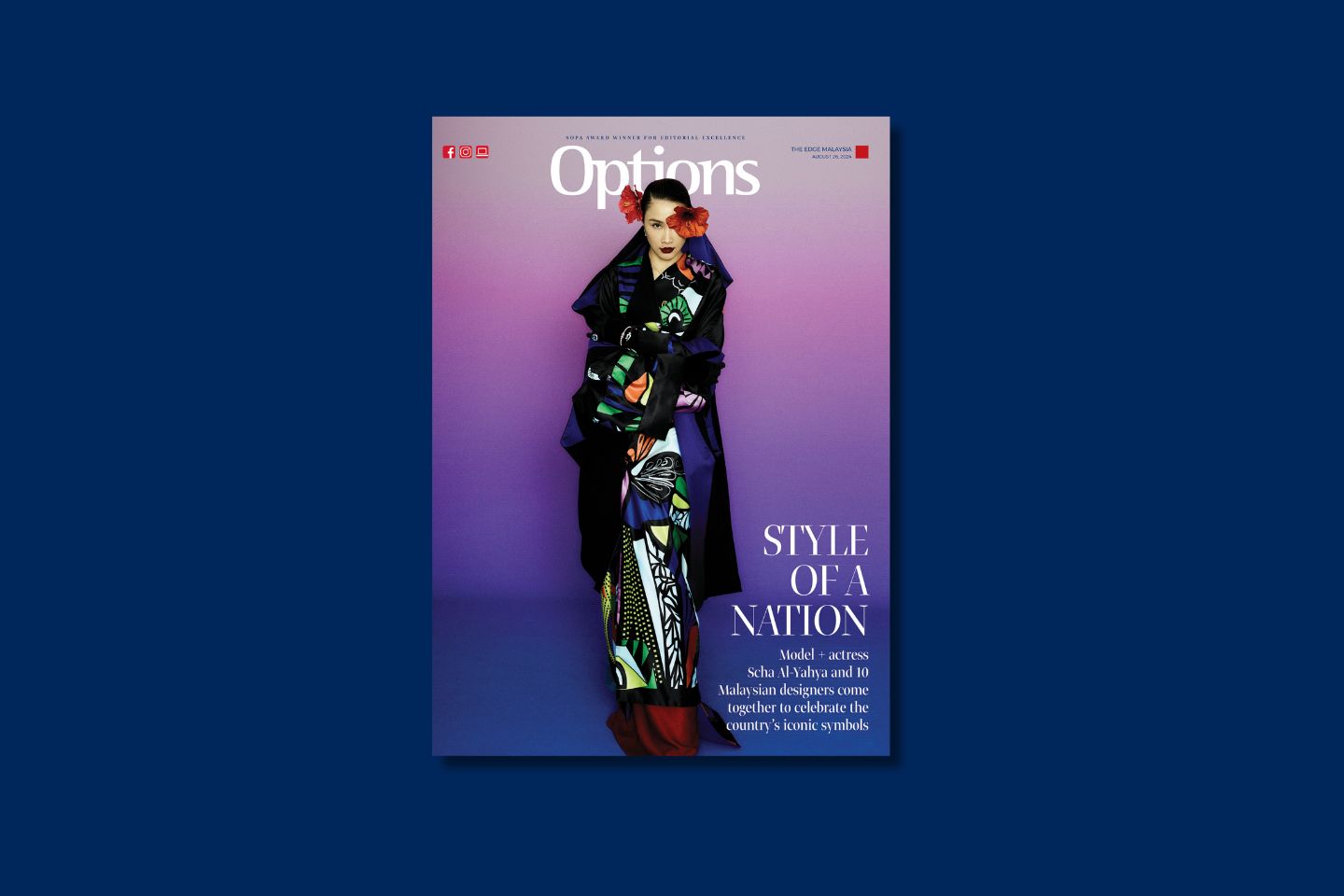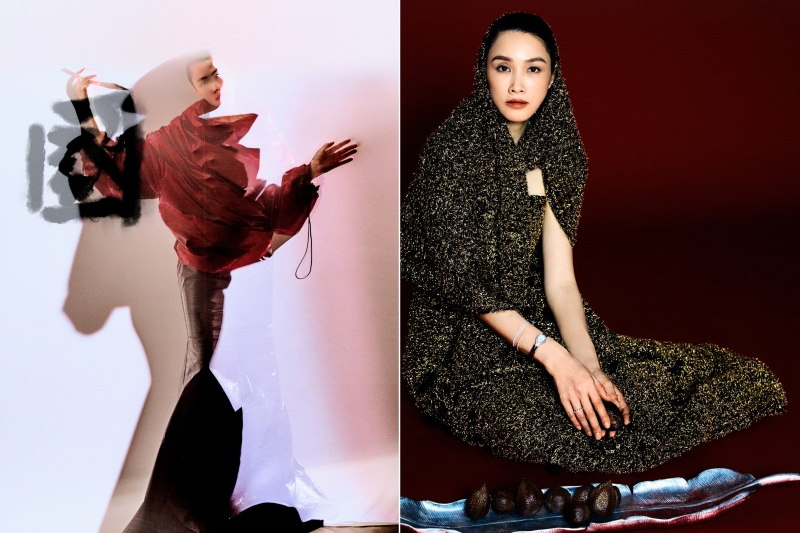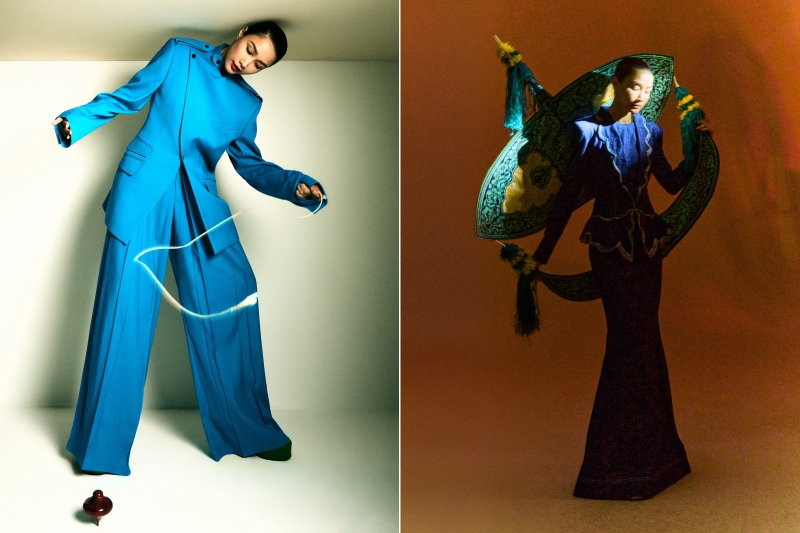
Scha Al-Yahya wears Syomirizwa Gupta paired with jewellery by Fred Paris. The bunga raya, represented by the red blossoms in her hair, has been Malaysia’s national flower since 1960. Its petals are a symbol of courage and said to represent the principles of the Rukun Negara. (Creative direction and styling: Colin Sim; Photography: Chee Wei; Hair: Cody Chua; Makeup: Plika Makeup)
In honour of the 67th anniversary of Merdeka, 10 of the country’s best and brightest sartorial talents — from the OGs to the rising stars — play dress up (albeit with a local twist) with one of the industry’s best-loved personalities — model, actress and TV host Scha Al-Yahya.
Durian
The undisputed King of Fruits takes its name from the Malay word duri or thorn. And when the season arrives, Malaysians practically go into a frenzy for its pungent-smelling, rich-tasting yellow flesh. The spiky fruit is not exclusive to the country, of course, but locals will proudly tell you that Malaysian durians are unrivalled while the variety is staggering. There is the celebrated Musang King as well as state-specific specialties like Red Prawn (Penang), IOI (Johor), Tekka (Selangor) and XO (Pahang).
It is also a fruit that cannot be plucked, with farmers setting up sturdy nets to catch the fruits as they fall to the ground once they are ripe and ready. Highly nutritious, it is rich in fibre, vitamins and packed with anti-inflammatory compounds and antioxidants — all this on top of being addictively delicious. Malaysia is a blessed land!
Founded in 2009 by Hafizi Radzi Woo, the Fiziwoo label is now a joint effort between him and architectural designer Izree Kai Haffiz. Pictured here is their Constellation pure denim butterfly-collared shirt with faux leather monogram pockets (RM1,888) worn with the Constellation pure denim midi-length circular cut skirt (RM1,988).
Wayang Kulit
Shadow puppetry is not unique to Malaysia although several states boast beautiful and unique localised takes on the art form. Wayang is Malay for “theatre” while kulit or “skin” stems from the animal hides used to fashion the intricately carved leather puppets. Most wayang kulit performances are based on stories from great ancient Indian epics like the Ramayana and collected orally over the centuries by storytelling puppeteers called Tok Dalang.
The lighting and music are haunting and the audience is always beguiled as the Tok Dalang conjures up adventures of Seri Rama and his wife Siti Dewi, accompanied by traditional instruments like the serunai (Malay oboe), geduk (Malay barrel drum), kesi (cymbals) and canang (brass percussion). Fast fading from our national heritage, live wayang kulit performances have become a rare treat for many Malaysians, young and old, with the percentage rising even more sharply as the great Tok Dalangs pass on.
Renowned for working with a primarily all-black palette, Kit Woo is famed for his focus on the classic métiers of shape, cut and draping. Here, Scha wears two of his deconstructed two-way trench coats (RM8,400 each) in black and sand, paired with Tiffany Lock small earrings in yellow gold (RM14,400) and Tiffany Lock bangles (RM32,700-RM69,500) by Tiffany & Co.
Congkak
Traditionally played with guli (marbles), seashells or smooth, dark seeds from the ubiquitous rubber tree, the objective of congkak is to capture the most pieces by the end of the game. It enjoys a long history in the country and is a much-loved indoor pastime. In bygone days, almost every home would have its own congkak set — a long, carved wooden board that resembles
a boat or barge.
Veteran womenswear designer Alia Bastamam is the go-to for contemporary interpretations of traditional styles. Here, a micro-pleated organza Aurora dress (RM3,500) is paired with a Cartier Baignoire timepiece (RM59,000), Panthère de Cartier bracelet (RM132,000), Panthère de Cartier ring (RM32,800) and Juste un Clou earrings (RM14,100). All by Cartier.
Calligraphy
A long history of trade and cross-cultural exchange has undoubtedly shaped the role calligraphy plays in the region today. Transcending time and geographical borders, the art of calligraphy in Asia dates back millennia although Malaysia’s may be traced back several centuries. The most famous and well-known example is the Jawi-inscribed Batu Bersurat Terengganu, although a recent archaeological dig in Bukit Choras, Kedah, unearthed two near-perfect statues bearing ancient Pallava script believed to be from the 8th- or 9th-century AD. Here, the word guo or “country” in Chinese script pays tribute to Malaysia’s multi-cultural harmony.
This twisted nylon jacket in wine red (RM599) by streetwear designer Masyadi Mansoor’s MSYD label celebrates his signature puffer aesthetic.
Buah Salak
With its reddish-brown skin that resembles a snake’s scales, it is no wonder the popular buah salak is also called snake fruit. Derived from a species of palm tree native to the region, the smallish fruit — about the size of a fig or rose apple — has a unique taste and texture. Fans liken it to bitter pineapple or jackfruit while detractors say it is like crunching on tasteless garlic cloves or chalky water chestnuts. Locals enjoy it raw although enterprising talents have been able to make juice, wine and candy from it.
The strapless demi couture Vivien mermaid gown by Khoon Hooi is made from a specially crafted tweed fabric. The dress is accented with draped detailing at the waistline and has a long train at its side that may be further styled as a shawl (RM19,000). On Scha’s wrist is the Joséphine Aigrette watch in stainless steel and diamonds (RM32,810) and the Bee My Love diamond bracelet (RM75,570 for white gold and RM71,495 for rose gold), while on her finger, she wears the Bee My Love ring (RM21,170 for rose gold and RM12,225 for yellow gold). All by Chaumet.
Harimau Malaya
The Malayan tiger makes its presence felt in all aspects of Malaysian life, as the symbol of banking giant Maybank, to the nickname for the national football team, to the core figures flanking the Jata Negara (coat of arms) of Malaysia. Sadly, it remains critically endangered. The future looks bleak for the majestic beast, dwindling from 3,000 wild tigers in the 1950s to less than 150 as at 2022, all due to the loss of habitat resulting from rampant development and, more disgustingly, poaching. It is alarming that wild tigers will possibly go extinct in Malaysia in our lifetime.
Renowned for her feminine and dreamy designs, this simple yet sensuous draped three-button cuff-sleeved maxi dress (RM359.90) by Nurita Harith should be a staple in every woman’s wardrobe. Here, it is paired with dramatic red gloves and Tiffany Lock bangles in rose, white and yellow gold (RM32,700-RM69,500) by Tiffany & Co.
Kudam
Traditional pots used by the Indian community, kudam (also sometimes referred to as kalash or kalasam) feature strongly in daily life as well as religious festivals, particularly Thaipusam, where devotees often bear a paal kudam (milk pot) atop their heads as an offering to Lord Murugan. In many homes and kitchens, copper ones are popular choices for storing drinking water. You may also see brass versions starring in Hindu puja rituals and ceremonies, often lined with mango leaves, a symbol of prosperity, fertility and the triumph of good over evil, and topped with a coconut — a representation of the sacred trinity of Brahma, Vishnu and Mahesh.
Rizman Nordin and Ruzaini Jamil, the dynamic duo behind the Rizman Ruzaini label, are the talents behind this red carpet-ready gown. The elegant evening look is paired with jewellery from Fope, including a Panorama rose and white gold ring with diamonds (RM28,800), Essentials rings in white and yellow gold (RM8,550 each), the Luna Pave bi-colour diamond necklace (RM147,000), the Luna bracelet in rose gold (43,500), the Panorama bracelet with diamonds in rose and white gold (RM180,750), and the Luna Pave bi-colour bracelet with diamonds in white and yellow gold (RM96,499). All from Suen Jewellers.
Gasing
Spinning gasing or traditional tops is a popular local pastime and part of the Malay state heritage. Its name is said to be a portmanteau of the words kayu (for the wood from which tops are made) and pusing (to spin). The spinning of tops, either competitively or for fun, is believed by villagers to bring about a good harvest.
Most popularly played in the state of Melaka, the traditional game is featured in two distinct types of tournaments: gasing pangkah, where the winning top strikes its contender out of a designated circle, or gasing uri, a spinning match. Traditional versions come in all shapes and sizes but the petite version seen here goes by the cute moniker of gasing toyol, or a demon baby in local ghostly folklore.
Feel blue but in a good way when you wear Sarawakian designer Dickson Lim’s smart Cobalt Enforcer blazer (RM3,200) paired with “skants” (RM1,450), his signature fusing of traditional skirt and pants. Both pieces are from Lim’s SS25 collection.
Wau Bulan
Shaped like the crescent moon after which it is named, the traditional wau bulan is a massive specimen, sometimes spanning metres in both width and length. Intricately adorned with motifs drawn from Malay culture, these kites are always brightly coloured so as to be visible high up in the air. Popularly flown in the East Coast states, particularly Kelantan, it remains a strong symbol of the country, with even the national carrier Malaysia Airlines basing its logo on it. Besides wau bulan, other popular shapes include wau ikan (fish), wau burung (bird), wau merak (peacock) and wau puyuh (quail).
This unique one-piece denim kebaya-style gown with white sulam embroidery (price upon application) was the first look down the aisle at Bernard Chandran’s recent 30 Years in Malay Contemporary Fashion showcase and is a testament to his decades of meticulous craftsmanship.
This article first appeared on Aug 26, 2024 in The Edge Malaysia.







